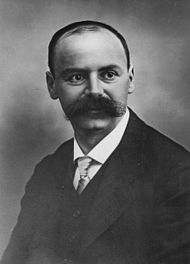
Back كارل شفارتسشيلد Arabic كارل شفارتسشيلد ARZ کارل شوارتزشیلد AZB Карл Шварцшыльд Byelorussian Карл Шварцшилд Bulgarian কার্ল শোয়ার্জশিল্ড Bengali/Bangla Karl Schwarzschild Breton Karl Schwarzschild Catalan Karl Schwarzschild Czech Karl Schwarzschild Danish
Karl Schwarzschild | |
|---|---|
 | |
| Born | 9 October 1873 |
| Died | 11 May 1916 (aged 42)[1]: xix Potsdam, German Empire |
| Alma mater | Ludwig Maximilian University of Munich University of Strasbourg |
| Scientific career | |
| Fields | Physics Astronomy |
| Doctoral advisor | Hugo von Seeliger |
| Military career | |
| Allegiance | |
| Service | Imperial German Army |
| Years of service | 1914–1916 |
| Rank | Lieutenant |
| Battles / wars | World War I |
Karl Schwarzschild (German: [kaʁl ˈʃvaʁtsʃɪlt] ⓘ; 9 October 1873 – 11 May 1916) was a German physicist and astronomer.
Schwarzschild provided the first exact solution to the Einstein field equations of general relativity, for the limited case of a single spherical non-rotating mass, which he accomplished in 1915, the same year that Einstein first introduced general relativity. The Schwarzschild solution, which makes use of Schwarzschild coordinates and the Schwarzschild metric, leads to a derivation of the Schwarzschild radius, which is the size of the event horizon of a non-rotating black hole.
Schwarzschild accomplished this while serving in the German army during World War I. He died the following year from the autoimmune disease pemphigus, which he developed while at the Russian front.[2][3] Various forms of the disease particularly affect people of Ashkenazi Jewish origin.[4][5][6]
Asteroid 837 Schwarzschilda is named in his honour, as is the large crater Schwarzschild, on the far side of the Moon.[7]
- ^ Biography of Karl Schwarzschild by Indranu Suhendro, The Abraham Zelmanov Journal, 2008, Volume 1.
- ^ Snygg, John (2012). A new approach to differential geometry using Clifford's geometric algebra. New York: Springer Science. p. 400. doi:10.1007/978-0-8176-8283-5. ISBN 978-0-8176-8283-5.
- ^ Ahsan, Zafar (2015). Tensors : mathematics of differential geometry and relativity. Delhi: Prentice Hall India. p. 205. ISBN 9788120350885.
- ^ Slomov, Elena; Loewenthal, Ron; Goldberg, Ilan; Korostishevsky, Michael; Brenner, Sara; Gazit, Ephraim (August 2003). "Pemphigus vulgaris in Jewish patients is associated with HLA-A region genes: mapping by microsatellite markers". Human Immunology. 64 (8): 771–779. doi:10.1016/s0198-8859(03)00092-2. ISSN 0198-8859. PMID 12878355. Retrieved 3 July 2022.
- ^ Vodo, Dan; Sarig, Ofer; Sprecher, Eli (14 August 2018). "The Genetics of Pemphigus Vulgaris". Frontiers in Medicine. 5: 226. doi:10.3389/fmed.2018.00226. PMC 6102399. PMID 30155467.
- ^ Pisanti, S.; Sharav, Y.; Kaufman, E.; Posner, L.N. (September 1974). "Pemphigus vulgaris: Incidence in Jews of different ethnic groups, according to age, sex, and initial lesion". Oral Surgery, Oral Medicine, Oral Pathology. 38 (3): 382–387. doi:10.1016/0030-4220(74)90365-X. PMID 4528670.
- ^ "Crater Schwarzschild". Gazetteer of Planetary Nomenclature. USGS Astrogeology Research Program.